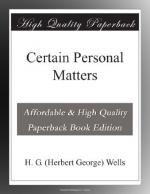Come to think of it, there is something singularly unreasonable about almost all floral symbolism. There is your forget-me-not, pink in the bud, and sapphire in the flower, with a fruit that breaks up into four, the very picture of inconstancy and discursiveness. Yet your lover, with a singular blindness, presents this to his lady when they part. Then the white water-lily is supposed to represent purity of heart, and, mark you, it is white without and its centre is all set about with innumerable golden stamens, while in the middle lies, to quote the words of that distinguished botanist, Mr. Oliver, “a fleshy disc.” Could there be a better type of sordid and mercenary deliberation maintaining a fair appearance? The tender apple-blossom, rather than Pretence, is surely a reminder of Eden and the fall of love’s devotion into inflated worldliness. The poppy which flaunts its violent colours athwart the bearded corn, and which frets and withers like the Second Mrs. Tanqueray so soon as you bring it to the shelter of a decent home, is made the symbol of Repose. One might almost think Aime Martin and the other great authorities on this subject wrote in a mood of irony.
The daisy, too, presents you Innocence, “companion of the milk-white lamb,” Mr. Miller calls it. I am sorry for the milk-white lamb. It was one of the earliest discoveries of systematic botany that the daisy is a fraud, a complicated impostor. The daisy is not a flower at all. It is a favourite trap in botanical examinations, a snare for artless young men entering the medical profession. Each of the little yellow things in the centre of the daisy is a flower in itself,—if you look at one with a lens you will find it not unlike a cowslip flower,—and the white rays outside are a great deal more than the petals they ought to be if the Innocence theory is to hold good. There is no such thing as an innocent flower; they are all so many deliberate advertisements to catch the eye of the undecided bee, but any flower almost is simpler than this one. We would make it the emblem of artistic deception, and the confidence trick expert should wear it as his crest.




